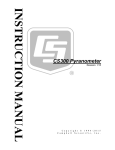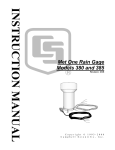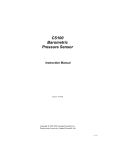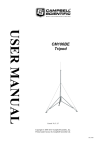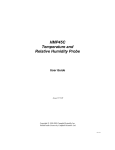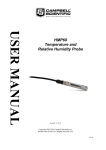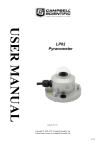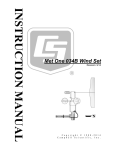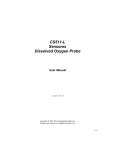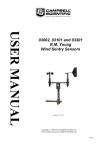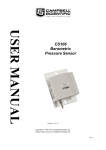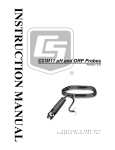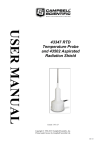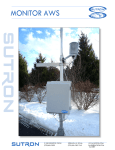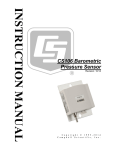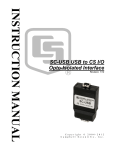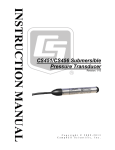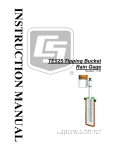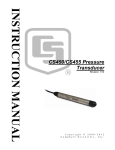Download CS300 Pyranometer - Campbell Scientific
Transcript
USER MANUAL CS300 Pyranometer Issued: 11.3.15 Copyright © 1994-2015 Campbell Scientific, Inc. Printed under licence by Campbell Scientific Ltd. CSL 570 Guarantee This equipment is guaranteed against defects in materials and workmanship. This guarantee applies for 24 months from date of delivery. We will repair or replace products which prove to be defective during the guarantee period provided they are returned to us prepaid. The guarantee will not apply to: Equipment which has been modified or altered in any way without the written permission of Campbell Scientific Batteries Any product which has been subjected to misuse, neglect, acts of God or damage in transit. Campbell Scientific will return guaranteed equipment by surface carrier prepaid. Campbell Scientific will not reimburse the claimant for costs incurred in removing and/or reinstalling equipment. This guarantee and the Company’s obligation thereunder is in lieu of all other guarantees, expressed or implied, including those of suitability and fitness for a particular purpose. Campbell Scientific is not liable for consequential damage. Please inform us before returning equipment and obtain a Repair Reference Number whether the repair is under guarantee or not. Please state the faults as clearly as possible, and if the product is out of the guarantee period it should be accompanied by a purchase order. Quotations for repairs can be given on request. It is the policy of Campbell Scientific to protect the health of its employees and provide a safe working environment, in support of this policy a “Declaration of Hazardous Material and Decontamination” form will be issued for completion. When returning equipment, the Repair Reference Number must be clearly marked on the outside of the package. Complete the “Declaration of Hazardous Material and Decontamination” form and ensure a completed copy is returned with your goods. Please note your Repair may not be processed if you do not include a copy of this form and Campbell Scientific Ltd reserves the right to return goods at the customers’ expense. Note that goods sent air freight are subject to Customs clearance fees which Campbell Scientific will charge to customers. In many cases, these charges are greater than the cost of the repair. Campbell Scientific Ltd, 80 Hathern Road, Shepshed, Loughborough, LE12 9GX, UK Tel: +44 (0) 1509 601141 Fax: +44 (0) 1509 601091 Email: [email protected] www.campbellsci.co.uk PLEASE READ FIRST About this manual Please note that this manual was originally produced by Campbell Scientific Inc. primarily for the North American market. Some spellings, weights and measures may reflect this origin. Some useful conversion factors: Area: 1 in2 (square inch) = 645 mm2 Length: Mass: 1 in. (inch) = 25.4 mm 1 ft (foot) = 304.8 mm 1 yard = 0.914 m 1 mile = 1.609 km 1 lb (pound weight) = 0.454 kg Pressure: 1 psi (lb/in2) = 68.95 mb Volume: 1 UK pint = 568.3 ml 1 UK gallon = 4.546 litres 1 US gallon = 3.785 litres 1 oz. (ounce) = 28.35 g In addition, while most of the information in the manual is correct for all countries, certain information is specific to the North American market and so may not be applicable to European users. Differences include the U.S standard external power supply details where some information (for example the AC transformer input voltage) will not be applicable for British/European use. Please note, however, that when a power supply adapter is ordered it will be suitable for use in your country. Reference to some radio transmitters, digital cell phones and aerials may also not be applicable according to your locality. Some brackets, shields and enclosure options, including wiring, are not sold as standard items in the European market; in some cases alternatives are offered. Details of the alternatives will be covered in separate manuals. Part numbers prefixed with a “#” symbol are special order parts for use with non-EU variants or for special installations. Please quote the full part number with the # when ordering. Recycling information At the end of this product’s life it should not be put in commercial or domestic refuse but sent for recycling. Any batteries contained within the product or used during the products life should be removed from the product and also be sent to an appropriate recycling facility. Campbell Scientific Ltd can advise on the recycling of the equipment and in some cases arrange collection and the correct disposal of it, although charges may apply for some items or territories. For further advice or support, please contact Campbell Scientific Ltd, or your local agent. Campbell Scientific Ltd, 80 Hathern Road, Shepshed, Loughborough, LE12 9GX, UK Tel: +44 (0) 1509 601141 Fax: +44 (0) 1509 601091 Email: [email protected] www.campbellsci.co.uk Precautions DANGER — MANY HAZARDS ARE ASSOCIATED WITH INSTALLING, USING, MAINTAINING, AND WORKING ON OR AROUND TRIPODS, TOWERS, AND ANY ATTACHMENTS TO TRIPODS AND TOWERS SUCH AS SENSORS, CROSSARMS, ENCLOSURES, ANTENNAS, ETC. FAILURE TO PROPERLY AND COMPLETELY ASSEMBLE, INSTALL, OPERATE, USE, AND MAINTAIN TRIPODS, TOWERS, AND ATTACHMENTS, AND FAILURE TO HEED WARNINGS, INCREASES THE RISK OF DEATH, ACCIDENT, SERIOUS INJURY, PROPERTY DAMAGE, AND PRODUCT FAILURE. TAKE ALL REASONABLE PRECAUTIONS TO AVOID THESE HAZARDS. CHECK WITH YOUR ORGANIZATION'S SAFETY COORDINATOR (OR POLICY) FOR PROCEDURES AND REQUIRED PROTECTIVE EQUIPMENT PRIOR TO PERFORMING ANY WORK. Use tripods, towers, and attachments to tripods and towers only for purposes for which they are designed. Do not exceed design limits. Be familiar and comply with all instructions provided in product manuals. Manuals are available at www.campbellsci.eu or by telephoning +44(0) 1509 828 888 (UK). You are responsible for conformance with governing codes and regulations, including safety regulations, and the integrity and location of structures or land to which towers, tripods, and any attachments are attached. Installation sites should be evaluated and approved by a qualified engineer. If questions or concerns arise regarding installation, use, or maintenance of tripods, towers, attachments, or electrical connections, consult with a licensed and qualified engineer or electrician. General • Prior to performing site or installation work, obtain required approvals and permits. Comply with all governing structure-height regulations, such as those of the FAA in the USA. • Use only qualified personnel for installation, use, and maintenance of tripods and towers, and any attachments to tripods and towers. The use of licensed and qualified contractors is highly recommended. • Read all applicable instructions carefully and understand procedures thoroughly before beginning work. • Wear a hardhat and eye protection, and take other appropriate safety precautions while working on or around tripods and towers. • Do not climb tripods or towers at any time, and prohibit climbing by other persons. Take reasonable precautions to secure tripod and tower sites from trespassers. • Use only manufacturer recommended parts, materials, and tools. Utility and Electrical • You can be killed or sustain serious bodily injury if the tripod, tower, or attachments you are installing, constructing, using, or maintaining, or a tool, stake, or anchor, come in contact with overhead or underground utility lines. • Maintain a distance of at least one-and-one-half times structure height, or 20 feet, or the distance required by applicable law, whichever is greater, between overhead utility lines and the structure (tripod, tower, attachments, or tools). • Prior to performing site or installation work, inform all utility companies and have all underground utilities marked. • Comply with all electrical codes. Electrical equipment and related grounding devices should be installed by a licensed and qualified electrician. Elevated Work and Weather • Exercise extreme caution when performing elevated work. • Use appropriate equipment and safety practices. • During installation and maintenance, keep tower and tripod sites clear of un-trained or non-essential personnel. Take precautions to prevent elevated tools and objects from dropping. • Do not perform any work in inclement weather, including wind, rain, snow, lightning, etc. Maintenance • Periodically (at least yearly) check for wear and damage, including corrosion, stress cracks, frayed cables, loose cable clamps, cable tightness, etc. and take necessary corrective actions. • Periodically (at least yearly) check electrical ground connections. WHILE EVERY ATTEMPT IS MADE TO EMBODY THE HIGHEST DEGREE OF SAFETY IN ALL CAMPBELL SCIENTIFIC PRODUCTS, THE CUSTOMER ASSUMES ALL RISK FROM ANY INJURY RESULTING FROM IMPROPER INSTALLATION, USE, OR MAINTENANCE OF TRIPODS, TOWERS, OR ATTACHMENTS TO TRIPODS AND TOWERS SUCH AS SENSORS, CROSSARMS, ENCLOSURES, ANTENNAS, ETC. Contents PDF viewers: These page numbers refer to the printed version of this document. Use the PDF reader bookmarks tab for links to specific sections. 1. Introduction ................................................................. 1 2. Cautionary Statements............................................... 1 3. Initial Inspection ......................................................... 1 4. Quickstart .................................................................... 1 5. Overview ...................................................................... 4 6. Specifications ............................................................. 4 7. Installation ................................................................... 5 7.1 7.2 Siting .................................................................................................... 5 Mounting to an Instrument Mount ....................................................... 6 7.2.1 Required Tools .............................................................................. 6 7.2.2 Mounting Procedure ..................................................................... 6 7.2.2.1 CM225E Solar Sensor Mounting Stand ............................. 6 7.3 Wiring to the Datalogger...................................................................... 8 7.4 Programming........................................................................................ 9 7.4.1 Total Solar Radiation .................................................................. 10 8. Maintenance and Calibration ................................... 11 9. Troubleshooting ....................................................... 11 Appendices A. Importing Short Cut Code Into CRBasic or Edlog Editor .......................................................... A-1 A.1 Importing Short Cut Code into a Program Editor ........................... A-1 A.1.1 CRBasic Datalogger................................................................. A-1 A.1.2 Edlog ........................................................................................ A-2 B. Example Programs ................................................. B-1 B.1 B.2 CR1000 Program ............................................................................. B-1 CR10X Example Program ............................................................... B-2 i Figure 7-1. CS300 schematic.................................................................................. 8 7-1. 7-2. Connections to Campbell Scientific Dataloggers................................. 9 Multipliers Required for Average Flux and Total Flux Density in SI and English Units ....................................................................... 10 Wiring for Example Programs ......................................................... B-1 Tables B-1. ii CS300 Pyranometer 1. Introduction The CS300, manufactured by Apogee Instruments, measures total sun and sky solar radiation for solar, agricultural, meteorological, and hydrological applications. Its spectral range of 360 to 1120 nanometers encompasses most of the shortwave radiation that reaches the Earth’s surface. This pyranometer connects directly to our dataloggers. Its output can be measured by all of our dataloggers. 2. 3. Cautionary Statements READ AND UNDERSTAND the Precautions section at the front of this manual. Care should be taken when opening the shipping package to not damage or cut the cable jacket. If damage to the cable is suspected, consult with a Campbell Scientific applications engineer. Remove the green cap after installing the sensor. Save this cap for shipping or storing the sensor. Handle the sensor carefully when cleaning. Be careful not to scratch the surface of the sensor. Initial Inspection 4. Upon receipt of the CS300, inspect the packaging and contents for damage. File damage claims with the shipping company. Quickstart Short Cut is an easy way to program your datalogger to measure the CS300 and assign datalogger wiring terminals. Use the following procedure to get started. 1. Install Short Cut by clicking on the install file icon. Get the install file from either www.campbellsci.com, the ResourceDVD, or find it in installations of LoggerNet, PC200W, PC400, or RTDAQ software. 1 CS300 Pyranometer 2 2. The Short Cut installation should place a Short Cut icon on the desktop of your computer. To open Short Cut, click on this icon. 3. When Short Cut opens, select New Program. 4. Select Datalogger Model and Scan Interval (default of 5 seconds is OK for most applications). Click Next. User Manual 5. Under the Available Sensors and Devices list, select Sensors | Meteorological | Solar Radiation folder. Select CS300 Pyranometer. Click to move the selection to the Selected device window. Default units are kW/m2 for flux density units and mJ/ m2 for total flux. These can be changed by clicking the Flux Density and Total Flux boxes and selecting different values. 6. After selecting the sensor, click at the left of the screen on Wiring Diagram to see how the sensor is to be wired to the datalogger. The wiring diagram can be printed out now or after more sensors are added. 7. Select any other sensors you have, then finish the remaining Short Cut steps to complete the program. The remaining steps are outlined in Short Cut Help, which is accessed by clicking on Help | Contents | Programming Steps. 3 CS300 Pyranometer 5. 8. If LoggerNet, PC400, RTDAQ, or PC200W is running on your PC, and the PC to datalogger connection is active, you can click Finish in Short Cut and you will be prompted to send the program just created to the datalogger. 9. If the sensor is connected to the datalogger, as shown in the wiring diagram in step 6, check the output of the sensor in the datalogger support software data display to make sure it is making reasonable measurements. Overview The CS300 measures incoming solar radiation with a silicon photovoltaic detector mounted in a cosine-corrected head. Output from the detector is a current, which is converted to voltage by a potentiometer potted in the sensor head. The resistance of the potentiometer is adjusted when the sensor is calibrated so that all sensors have the same output sensitivity. The CS300 is calibrated against a Kipp and Zonen CM21 under natural sunlight to accurately measure sun plus sky radiation (360 to 1120 nm). The CS300 should not be used under vegetation or artificial lights. During the night, the CS300 may read slightly negative incoming solar radiation. This negative signal is caused by RF noise passing through the photo-diode. Negative values may be set to zero in the datalogger program. For more theoretical information on the silicon photovoltaic detector see Kerr, J. P., G. W. Thurtell, and C. B. Tanner: An integrating pyranometer for climatological observer stations and mesoscale networks. J. Appl. Meteor., 6, 688-694. 6. Specifications Features: Designed for continuous, long term, unattended operation in adverse conditions Dome-shaped head prevents water from accumulating on the sensor head Compatible with the CWS900-series interfaces, allowing it to be used in a wireless sensor network Compatible with Campbell Scientific CRBasic dataloggers: CR6, CR200(X) series, CR800 series, CR1000, CR3000, CR5000, and CR9000(X). Also compatible with Edlog dataloggers: CR500, CR510, CR10(X), CR23X, CR7, and 21X 4 Power requirements: none, self-powered Sensitivity: 5 W m–2 mV–1 (0.2 mV W–1 m–2) Absolute accuracy: ±5% for daily total radiation Cosine response: ±5% at 75° zenith angle. ±2% at 45° zenith angle Response time: <1 ms Temperature response: <1% at 5 to 40 °C Long-term stability: <2% per year Operating temperature: –40 to +70 °C Relative humidity: 0 to 100% User Manual Output: 0.2 mV per W m–2 Diameter: 2.4 cm (0.9 in) Height: 2.5 cm (1.0 in) Weight: 65 g (2.3 oz) with 2 m lead wire Measurement range: 0 to 1750 W m–2 (full sunlight 1000 W m–2) Light spectrum waveband: NOTE 7. 360 to 1120 nm (wavelengths where response is 10% of maximum) The black outer jacket of the cable is Santoprene® rubber. This compound was chosen for its resistance to temperature extremes, moisture, and UV degradation. However, this jacket will support combustion in air. It is rated as slow burning when tested according to U.L. 94 H.B. and will pass FMVSS302. Local fire codes may preclude its use inside buildings. Installation If you are programming your datalogger with Short Cut, skip Section 7.3, Wiring to the Datalogger, and Section 7.4, Programming. Short Cut does this work for you. See Section 4, Quickstart, for a Short Cut tutorial. 7.1 Siting The CS300 should be mounted such that no shadows or reflections are cast on it by the tripod/tower or other sensors. The sensor should be mounted with the cable pointing towards the nearest magnetic pole. For example, in the Northern Hemisphere, point the cable toward the North Pole. Mounting height is not critical for the accuracy of the measurement. However, pyranometers mounted at heights of 3 m or less are easier to level and clean. 5 CS300 Pyranometer 7.2 Mounting to an Instrument Mount 7.2.1 Required Tools Tools required for installation on a tripod or tower: Small and medium Phillips screwdrivers 1/2 in open end wrench for CM225E Tape measure UV-resistant cable ties Side-cut pliers Compass Step ladder 7.2.2 Mounting Procedure 7.2.2.1 CM225E Solar Sensor Mounting Stand CAUTIONThe CM225E should never be mounted directly to a vertical pipe. Instead the CM225E should be mounted to a crossarm. This avoids reflections from the vertical pipe onto the sensor. 1. Mount the crossarm to the tripod or tower. 2. Place the CM225E’s U-bolt in the bottom holes and secure the CM225E to the crossarm by tightening the U-bolt nuts. CM225E Stand U-bolt Nuts CM200-Series Crossarm 6 User Manual 3. Place the CS300 in the centre of the 010355 base/levelling fixture. Holes for Mounting Screws Levelling Screws 010355 Base 4. Loosely mount the 010355 base/levelling fixture on the CM225E. Do not fully tighten the three mounting screws. Holes for Mounting Screws Levelling Screw Mounting Screw Bubble Level 5. Turn the levelling screws as required to bring the bubble of the bubble level within the ring. 6. Tighten the mounting screws to secure the assembly in its final position. Check that the pyranometer is still correctly levelled and adjust as necessary. 7. Route the sensor cable along the underside of the crossarm to the tripod/tower, and to the instrument enclosure. 8. Secure the cable to the crossarm and mast using cable ties. 7 CS300 Pyranometer Cable Tie 9. 7.3 Remove the green cap after installing the sensor. Save this cap for shipping or storing the sensor. Wiring to the Datalogger A schematic diagram of the CS300 is shown in Figure 7-1. Single-Ended Analog Input Ground/AG Ground/G RED 500 to 600 typical BLACK CLEAR Figure 7-1. CS300 schematic Connections to Campbell Scientific dataloggers are given in Table 7-1. When Short Cut is used to create the datalogger program, the sensor should be wired to the channels shown in the wiring diagram created by Short Cut. 8 User Manual Table 7-1. Connections to Campbell Scientific Dataloggers 7.4 CR6 CR9000(X) CR5000 CR3000 CR1000 CR800 CR850 CR510 CR500 CR10(X) 21X CR7 CR23X CR200(X) SE Analogue SE Analogue SE Analogue Colour Wire Label Red Signal Black Signal Reference AG Clear Shield G SE Analogue Programming Short Cut is the best source for up-to-date datalogger programming code. Programming code is needed, when creating a program for a new datalogger installation when adding sensors to an existing datalogger program If your data acquisition requirements are simple, you can probably create and maintain a datalogger program exclusively with Short Cut. If your data acquisition needs are more complex, the files that Short Cut creates are a great source for programming code to start a new program or add to an existing custom program. NOTE Short Cut cannot edit programs after they are imported and edited in CRBasic Editor. A Short Cut tutorial is available in Section 4, Quickstart. If you wish to import Short Cut code into either Edlog or CRBasic Editor to create or add to a customized program, follow the procedure in Appendix A, Importing Short Cut Code Into CRBasic or Edlog Editor. Programming basics for CRBasic and Edlog dataloggers are provided below. Complete program examples for select dataloggers can be found in Appendix B, Example Programs. The output from the CS300 is 0.2 mV per Wm–2. The voltage signal from the CS300 is measured using the single-ended voltage instruction (VoltSE in CRBasic or Volt (SE) (P1) in Edlog). Dataloggers that use CRBasic include the CR200(X), CR800, CR850, CR1000, CR3000, CR5000, and CR9000(X). Dataloggers that use Edlog include CR7, CR10(X), CR510, and CR23X. Solar radiation can be recorded as an average flux density (W m–2) or daily total flux (MJ m–2). The appropriate multipliers are listed in Table 7-2. Negative values should be set to zero before being processed. 9 CS300 Pyranometer Table 7-2. Multipliers Required for Average Flux and Total Flux Density in SI and English Units UNITS MULTIPLIER PROCESS W m-2 5.0 Average t • 0.000005 Total t • 0.005 Total 0.005 • (1.434) Average t • 0.005 • (0.0239) Total -2 MJ m kJ m-2 –2 cal cm min cal cm–2 –1 t = datalogger execution interval in seconds Nearby AC power lines, electric pumps, or motors can be a source of electrical noise. If the sensor or datalogger is located in an electrically noisy environment, the measurement should be made with the 60 or 50 Hz rejection integration option as shown in the example programs. 7.4.1 Total Solar Radiation If solar radiation is totalized in units of kJ m–2, there is a possibility of over ranging the output limits. For CRBasic dataloggers, you can avoid this by using the IEEE4 or long data format. With the Edlog dataloggers the largest number that the datalogger can output to final storage is 6999 in low resolution (default), and 99999 in high resolution. For Edlog dataloggers, if you assume that the daily total flux is desired in kJ m–2 and assume an irradiance of 0.5 kW m–2, the maximum low resolution output limit will be exceeded in just under four hours. This value was found by taking the maximum flux the datalogger can record in low resolution and dividing by the total hourly flux. 3.9 hr 6999 kJ m 2 0.5 kJ m 2 s 1 3600 s hr 1 (1) To circumvent this limitation for Edlog dataloggers, record an average flux. Then, during post processing, multiply the average flux by the number of seconds in the output interval to arrive at an output interval flux. Sum the output interval totals over a day to find a daily total flux. Another alternative for Edlog dataloggers is to record total flux using the high resolution format. Instruction 78 is used to switch to the high resolution. The disadvantage of the high resolution format is that it takes more memory per data point. 10 User Manual 8. Maintenance and Calibration On a monthly basis the level of the pyranometer should be checked. Any dust or debris on the sensor head should be removed. The debris can be removed with a blast of compressed air or with a soft bristle, camel hair brush. CAUTION Handle the sensor carefully when cleaning. Be careful not to scratch the surface of the sensor. Recalibrate the CS300 every three years. Obtain an RMA number before returning the CS300 to Campbell Scientific, Inc. for recalibration. 9. Troubleshooting Symptom: –9999 or radiation values around 0 1. Check that the sensor is wired to the single-ended channel specified by the measurement instruction. 2. Verify that the range code is correct for the datalogger type. 3. Disconnect the sensor leads from the datalogger and use a DVM to check the voltage between the red (+) and the black (–) wires. The voltage should be 0 to 200 mV for 0 to 1000 Wm–2 radiation. No voltage indicates a problem with either the photodiode or the shunt resistor, both of which are potted in the sensor head and cannot be serviced. Symptom: Incorrect solar radiation NOTE 1. Make sure the top surface of the sensor head is clean, and that the sensor is properly levelled. 2. Verify that the range code, multiplier and offset parameters are correct for the desired engineering units and datalogger type. Jumps of 3 to 6 Wm–2 are typical of CR200(X) measurements, due to the 0.6 mV CR200(X) resolution and the 0.2 mV/Wm–2 CS300 sensitivity. 11 Appendix A. Importing Short Cut Code Into CRBasic or Edlog Editor This tutorial shows: How to import a Short Cut program into a program editor for additional refinement How to import a wiring diagram from Short Cut into the comments of a custom program A.1 Importing Short Cut Code into a Program Editor Short Cut creates files that can be imported into either CRBasic Editor or Edlog program editor. These files normally reside in the C:\campbellsci\SCWin folder and have the following extensions: .DEF (wiring and memory usage information) .CR6 (CR6 datalogger code) .CR2 (CR200(X) datalogger code) .CR1 (CR1000 datalogger code) .CR8 (CR800 datalogger code) .CR3 (CR3000 datalogger code) .CR5 (CR5000 datalogger code) .CR9 (CR9000(X) datalogger code) .DLD (contain code for CR10(X), CR23X, CR500, CR510, 21X, or CR7(X) dataloggers) The following procedures show how to import these files for editing. A.1.1 CRBasic Datalogger Use the following procedure to import Short Cut code into CRBasic Editor (CR200(X), CR1000, CR800, CR3000, CR5000 dataloggers). NOTE 1. Create the Short Cut program following the procedure in Section 4, Quickstart. Finish the program and exit Short Cut. Make note of the file name used when saving the Short Cut program. 2. Open CRBasic Editor. 3. Click File | Open. Assuming the default paths were used when Short Cut was installed, navigate to C:\CampbellSci\SCWin folder. The file of interest has a “.CR6”, “.CR2”, “.CR1”, “.CR8”, “.CR3”, “.CR5”, or “.CR9” extension, for CR200(X), CR1000, CR800, CR3000, CR5000, or CR9000(X) dataloggers, respectively. Select the file and click Open. 4. Immediately save the file in a folder different from \Campbellsci\SCWin, or save the file with a different file name. Once the file is edited with CRBasic Editor, Short Cut can no longer be used to edit the datalogger program. Change the name of the program file or move it, or Short Cut may overwrite it next time it is used. 5. The program can now be edited, saved, and sent to the datalogger. A-1 Appendix A. Importing Short Cut Code Into CRBasic or Edlog Editor 6. Import wiring information to the program by opening the associated .DEF file. Copy and paste the section beginning with heading “-Wiring for CRXXX–” into the CRBasic program, usually at the head of the file. After pasting, edit the information such that a ' character (single quotation mark) begins each line. This character instructs the datalogger compiler to ignore the line when compiling the datalogger code. A.1.2 Edlog Use the following procedure to import Short Cut code into the Edlog program editor (CR10(X), CR500, CR510, CR23X, CR7, or 21X dataloggers). NOTE A-2 1. Create the Short Cut program following the procedure in Section 4, Quickstart. Finish the program and exit Short Cut. Make note of the file name used when saving the Short Cut program. 2. Open Edlog. 3. Click File | Document DLD File. Assuming the default paths were used when Short Cut was installed, navigate to C:\CampbellSci\SCWin folder. The file of interest has a “.DLD” extension. Select the file and click Open. The .dld file, which is a type of ASCII machine code, is imported, documented, and, when saved, given a “.CSI” extension. 4. Immediately save the file in a folder different from \Campbellsci\SCWin, or save the file with a different file name. Once the file is edited with Edlog, Short Cut can no longer be used to edit the program. Change the name of the program file or move it, or Short Cut may overwrite it. 5. The program can now be edited, saved, and sent to the datalogger. 6. Import wiring information to the program by opening the associated .DEF file. Copy and paste the section beginning with heading “-Wiring for CRXXX–” into the Edlog program, usually at the head of the file. After pasting, edit the information such that a ; (semicolon) begins each line, which instructs the datalogger compiler to ignore the line when compiling the datalogger code. Appendix B. Example Programs The following programs measure the CS300 every 10 s and convert the millivolt output to Wm–2 and MJm–2. Both programs output an hourly average flux (Wm–2), and a daily total flux density (MJm–2). Negative values are set to zero before being processed. Wiring for the examples is given in Table B-1. Table B-1. Wiring for Example Programs Colour Description CR1000 CR10X Red Signal SE 1 SE 1 Black Signal Ground AG Clear Shield G B.1 CR1000 Program 'CR1000 'Declare Variables and Units Public SlrW Public SlrMJ Units SlrW=W/m² Units SlrMJ=MJ/m² 'Define Data Tables DataTable(Table1,True,-1) DataInterval(0,60,Min,10) Average(1,SlrW,FP2,False) EndTable DataTable(Table2,True,-1) DataInterval(0,1440,Min,10) Totalize(1,SlrMJ,IEEE4,False) EndTable 'Main Program BeginProg Scan(10,Sec,1,0) 'Measure CS300 Pyranometer VoltSe (SlrW,1,mV250,1,1,0,_60Hz,1.0,0) 'Set negative values to zero If SlrW<0 Then SlrW=0 use 1000 mV range for the CR5000, CR9000 For the CR1000, use the Auto Range or mV 2500 range for > 1200 w/m2 intensities. 'Convert mV to MJ/m² for a 10 second scan rate SlrMJ=SlrW*0.00005 'Convert mV to W/m² SlrW=SlrW*5.0 'Call Data Tables and Store Data CallTable(Table1) CallTable(Table2) NextScan EndProg B-1 Appendix B. Example Programs B.2 CR10X Example Program ;{CR10X} *Table 1 Program 01: 10.0000 Execution Interval (seconds) ; Measure CS300 pyranometer 1: Volt (SE) (P1) 1: 1 Reps 2: 24 250 mV 60 Hz Rejection Range ; use 500 mV range for the CR7 and 21X, 1000 mV range for the CR23X. For the 3: 1 SE Channel CR10X, use range code 0 or 25 for 4: 1 Loc [ SlrW ] > 1200 w/m2 intensities. 5: 1.0 Multiplier 6: 0.0 Offset ; Set negative values to zero 2: If 1: 2: 3: 4: 3: 1: 2: 3: 4: (X<=>F) (P89) 1 X Loc [ SlrW 4 < 0 F 30 Then Do ] Z=F x 10^n (P30) 0 F 0 n, Exponent of 10 1 Z Loc [ SlrW ] End (P95) ; Convert mV to MJ/m2 for 10 second execution interval 5: Z=X*F (P37) 1: 1 2: .00005 3: 2 X Loc [ SlrW F Z Loc [ SlrMJ ] ] ; Convert mV to W/m2 6: Z=X*F (P37) 1: 1 2: 5 3: 1 X Loc [ SlrW F Z Loc [ SlrW ] ] 7: If 1: 2: 3: time is (P92) 0 Minutes (Seconds --) into a 60 Interval (same units as above) 10 Set Output Flag High (Flag 0) 8: Set Active Storage Area (P80) 1: 1 Final Storage Area 1 2: 101 Array ID 9: Real Time (P77) 1: 1220 Year,Day,Hour/Minute (midnight = 2400) 10: Average (P71) 1: 1 Reps 2: 1 Loc [ SlrW ] 11: If time is (P92) 1: 0 Minutes (Seconds --) into a 2: 1440 Interval (same units as above) 3: 10 Set Output Flag High (Flag 0) 12: Set Active Storage Area (P80) 1: 1 Final Storage Area 1 2: 102 Array ID 13: Real Time (P77) 1: 1220 Year,Day,Hour/Minute (midnight = 2400) B-2 Appendix B. Example Programs 14: Resolution (P78) 1: 1 High Resolution 15: Totalize (P72) 1: 1 Reps 2: 2 Loc [ SlrMJ ] 16: Resolution (P78) 1: 0 Low Resolution B-3 CAMPBELL SCIENTIFIC COMPANIES Campbell Scientific, Inc. (CSI) 815 West 1800 North Logan, Utah 84321 UNITED STATES www.campbellsci.com [email protected] Campbell Scientific Africa Pty. Ltd. (CSAf) PO Box 2450 Somerset West 7129 SOUTH AFRICA www.csafrica.co.za [email protected] Campbell Scientific Australia Pty. Ltd. (CSA) PO Box 8108 Garbutt Post Shop QLD 4814 AUSTRALIA www.campbellsci.com.au [email protected] Campbell Scientific do Brazil Ltda. (CSB) Rua Apinagés, nbr. 2018 - Perdizes CEP: 01258-00 São Paulo SP BRAZIL www.campbellsci.com.br [email protected] Campbell Scientific Canada Corp. (CSC) 14532 – 131 Avenue NW Edmonton, Alberta T5L 4X4 CANADA www.campbellsci.ca [email protected] Campbell Scientific Centro Caribe S.A. (CSCC) 300N Cementerio, Edificio Breller Santo Domingo, Heredia 40305 COSTA RICA www.campbellsci.cc [email protected] Campbell Scientific Ltd. (CSL) 80 Hathern Road, Shepshed, Loughborough LE12 9GX UNITED KINGDOM www.campbellsci.co.uk [email protected] Campbell Scientific Ltd. (France) 3 Avenue de la Division Leclerc 92160 ANTONY FRANCE www.campbellsci.fr [email protected] Campbell Scientific Spain, S. L. Avda. Pompeu Fabra 7-9 Local 1 - 08024 BARCELONA SPAIN www.campbellsci.es [email protected] Campbell Scientific Ltd. (Germany) Fahrenheitstrasse13, D-28359 Bremen GERMANY www.campbellsci.de [email protected] Campbell Scientific (Beijing) Co., Ltd. 8B16, Floor 8 Tower B, Hanwei Plaza 7 Guanghua Road, Chaoyang, Beijing 100004 P.R. CHINA www.campbellsci.com [email protected] Please visit www.campbellsci.com to obtain contact information for your local US or International representative.




























